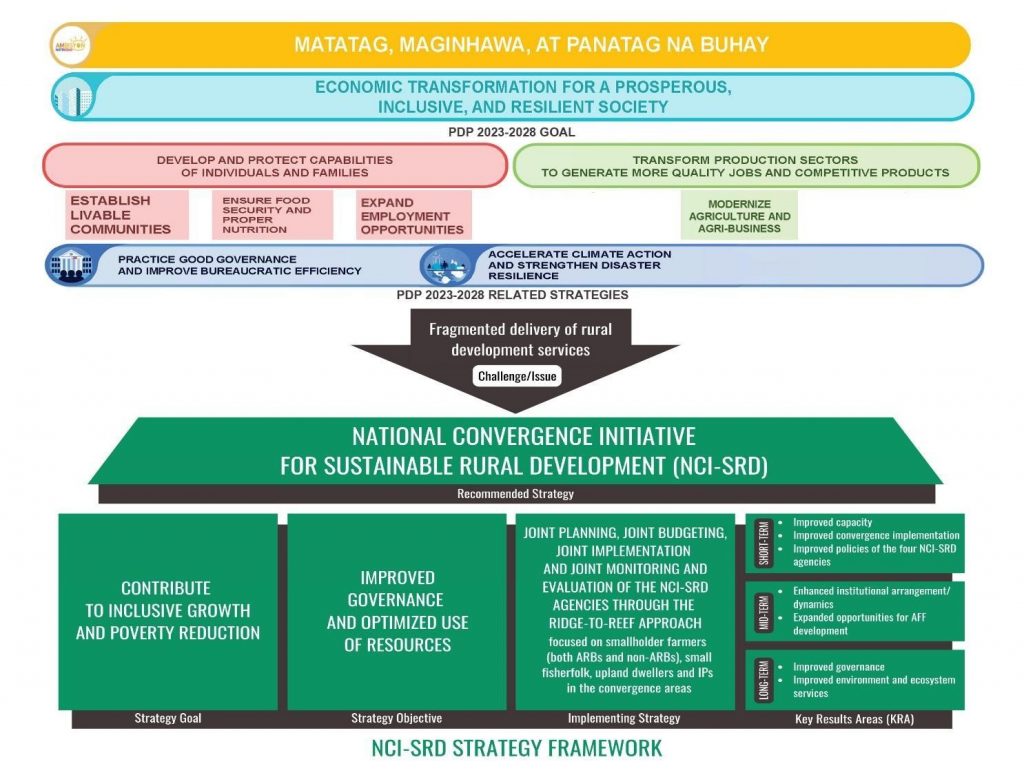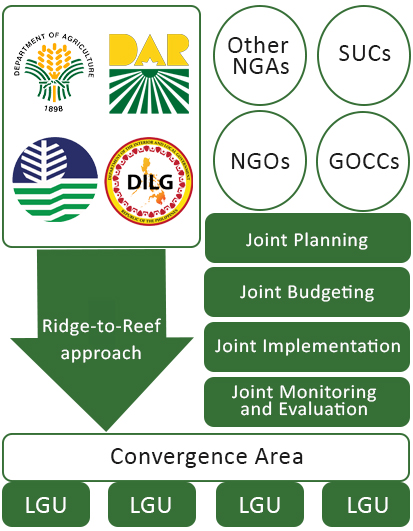The NCI-SRD is a government strategy of the DA-DAR-DENR-DILG as the four main rural development agencies operating under Joint Administrative Order No. 01, series of 2020, “Revised DA-DAR-DENR-DILG JAO No. 1, series of 2015 (Strengthening the Implementation Framework for the DA-DAR-DENR-DILG NCI-SRD)”. It is a response to the fragmented delivery of rural development services towards improved governance and optimized use of resources through a watershed and major river basin management and rehabilitation.
The convergence initiative is operationalized in convergence areas through a Convergence Area Development Plan (CADP). Interventions shall focus on smallholder farmers (both agrarian reform beneficiaries or non-ARBS), fisherfolk, upland dwellers, and indigenous peoples (IPs) using the ridge-to-reef approach as the framework for its interventions.
Vision
An efficient and effective strategy for rural development towards sustainable agriculture, forestry and fishery-based economy, social equity, ecological integrity, clean and healthy environment.
Mission
To complement and mainstream efforts of NCI-SRD agencies and other stakeholders for rural development through establishment of convergence areas using the ridge-to-reef approach.
DA-DAR-DENR-DILG Joint Administrative Order No. 1, series of 2020: “Revised DA-DAR-DENR-DILG JAO No. 1, series of 2015 (Strengthening the Implementation Framework for the DA-DAR-DENR-DILG National Convergence Initiative for Sustainable Rural Development)”

The overall goal is to contribute to inclusive growth and poverty reduction through improved governance and optimized use of resources. The strategic approach of the convergence strategy is the ridge-to-reef approach through the complementation and mainstreaming of efforts and resources for the joint planning, budgeting, implementation and monitoring, and evaluation of the DA-DAR-DENR-DILG and other stakeholders in strengthening LGUs to grow sustainable local economies for the smallholder farmers, fisherfolk, upland dwellers and IPs in the convergence areas.
Key result areas are also identified for short-term, medium-term, and long-term periods. These results are expected to address the overall challenge/issue of the fragmented delivery of rural development services. As a whole, the strategy is anchored on Ambisyon Natin 2040 and PDP 2023-2028.
Joint Planning
1. Identified common focused constituency and area
2. Harmonized and synchronized planning at all levels (municipal, provincial, regional, and national)
a. Formulated and agreed among key rural development players in the CADP
b. Agreed funding commitment from key rural development players/other stakeholders.
Joint Budgeting
1. Complementation of resources (financial and manpower)
2. Mobilization of and increase in investments from other institutions (specifically from the private sector: private-public partnership)
Joint Implementation
1. More timely and synchronized delivery of services (with reference to the agreed CADP)
2. Developed and established institutional arrangements for the management and implementation of projects
3. Established market linkages and network
4. Increase the level of participation and engagement of the constituency in all aspects of the development cycle (planning, implementation, monitoring and evaluation)
Joint Monitoring and Evaluation
1. Developed and established RBME system for the convergence areas
2. Impact assessment of the convergence areas



Beneficiaries

Smallholder Farmers
including Agrarian Reform Beneficiaries

Fisherfolk

Upland Dwellers







